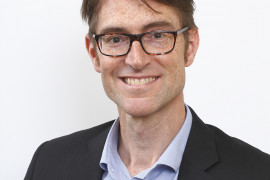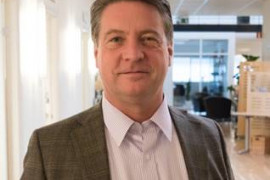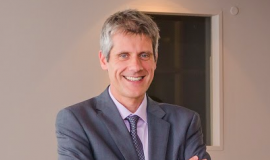
Marc Barrier, the CEO of Compagnie Parisienne de Chauffage Urbain (CPCU), the leading French district heating network, explains the specificities and developments of the Parisian network to us.
Can you give us an introduction to the CPCU?
CPCU was founded in 1927. It is a local public company owned two-thirds by Engie and a third by the City of Paris. By delegation of public service (maturing on January 31, 2024), our mission is to meet the needs in Paris heat. We heat about a third of its surface built for a quarter of the heating needs and hot water. This is a network of 480 km and a return water network of 320 km, and 20 loops of hot water as in some districts, we favored the loop from the steam. CPCU is today the first French heating network, the 7th European and World 11th in terms of TWh sold.
Are you only present in Paris?
The City has mandated us for heating, but extensions were made in some cities in inner suburbs. Today we also operate in 16 of these cities (Levallois-Perret, Saint-Denis, Boulogne-Billancourt, Ivry-sur-Seine, Issy-les-Moulineaux …), but usually indirectly, ie we sell another delegate. All these sales in the suburbs represents 10% of our overall sales.
Does the CPCU have features that are not found elsewhere?
The most important is probably the size of our network. An average heating network in the Paris region is 100 GWh; means network in France is 50 GWh: ours is 5,500 GWh, a hundred times more than a traditional French network! Another feature bias, from the 1940s to link the Parisian heat network to incineration plants. So today we value 100% of the heat production of the three plants Syctom (waste treatment union in the Paris region), representing 40% of our supply.
This presumably involves both external and internal production?
Yes, 40% of our production comes so Syctom and 60% of our own power plants (8 in number). So we set up a semi-automatic dispatching who works as an air traffic control tower. This requires us to a very fine coordination. You should know that our heating system has an inertia of 30 minutes. If an incineration plant stops, we have twenty minutes to take over, which implies constantly mobilize emergency “hot”.
What is your energy mix?
On 1 January 2016, we will achieve 50% renewable. With the enhancement of incineration plants, but also geothermal, biofuel (which account for about 2%) and biomass that will count for nearly 10% of our mix. The second part consisted of gas and 30% coal to 16%.
The use of biomass is something new for you?
Yes, and we come to it to make a major logistics facility. We have transformed the coal boilers in Saint-Ouen-wood coal, with the use of wood pellets. Granules particular since these black pellets that we will be the first in Europe to use. These are steam treated pellets which offer the advantage of being hydrophobic (storable outside) on the one hand and produce little dust, thereby reducing the explosion risks other.
Do you not have a wood supply problem?
Not on the granules internationally. The market is very tonic. We made a tender based on a consumption of 140 000 tons of wood per year. We received five responses quite admissible. However, we have not succeeded in mobilizing the French sector that could offer us that 40 000 tonnes. This industry mainly sells to individuals, for wood stoves.
What are the difficulties in operating in a dense urban area like Paris?
This implies strong constraints and heavy investment. For example, to limit our emissions, we have to transform five of our oil-fired gas power plants, representing an investment of 100 million euros. For our wood boiler of Saint-Ouen, we have not been allowed to make truck transportation. So we do it by rail, with trains arriving at the foot of the central and boilers fed by conveyor belts. Last example: the work. Pull networks in a city like Paris is very restrictive in terms of road clearance. Moreover, we are examining the possibility of casings of the return water network to avoid ripping the streets.
Will a project like the Grand Paris Express, which involves digging up a lot of Paris, cause problems for your network?
Not the Grand Paris Express, in the sense that it is on the outskirts, we only have a marginal impact as the Kremlin Bicetre. However, we do have a big issue with the rise of public transport such as trams and metro extensions. We can not leave a heat network in the grip of a tram, this requires us to mislead. We now move large steam feeders on the boulevards of the Marshals, northwest of Paris, for the tram. It costs us 25 million euros. And it also diverts feeder side Clichy and Saint-Ouen for the extension of metro line 14.
Are there underground networks mapped out well enough to make this work?
There is a central database of the City of Paris that we consult as soon as we wish to developments. But there are still surprises. The biggest are from old abandoned networks, water, sewerage or telecoms which are no longer listed.
What does the prospect of the creation of a joint cooling network in Paris mean for you?
In reality, if the CPCU created the Paris of cooling network called Climespace, the two companies are now completely severed since Climespace is a 100% subsidiary of Engie group. There is little interface between us, apart from some joint projects such as geothermal trigeneration in Aubervilliers. And cooling networks pass through sewage systems, which can not be our case for safety reasons.
What is your view on the future of heating networks?
They are well developed in recent years, under the combined effects of rising energy prices and the issue of greenhouse gas (GHG) emissions. Technologies have also favored them, which today leads us to work on the recovery and reclamation of waste energy, local and renewable. We are, for example, high demand for data center energy recovery or collection operations calories of sanitation. Now the question of the fall in gas prices, driven by the production of shale gas in the United States, which serves heating networks.
Is the law on energy transition a step in the right direction?
Yes, for example those objectives displayed on the carbon tax of 56 euros per tonne in 2020 and 100 euros in 2030 still was the impression that a light bulb went on, we never reason as forward in terms of energy.





